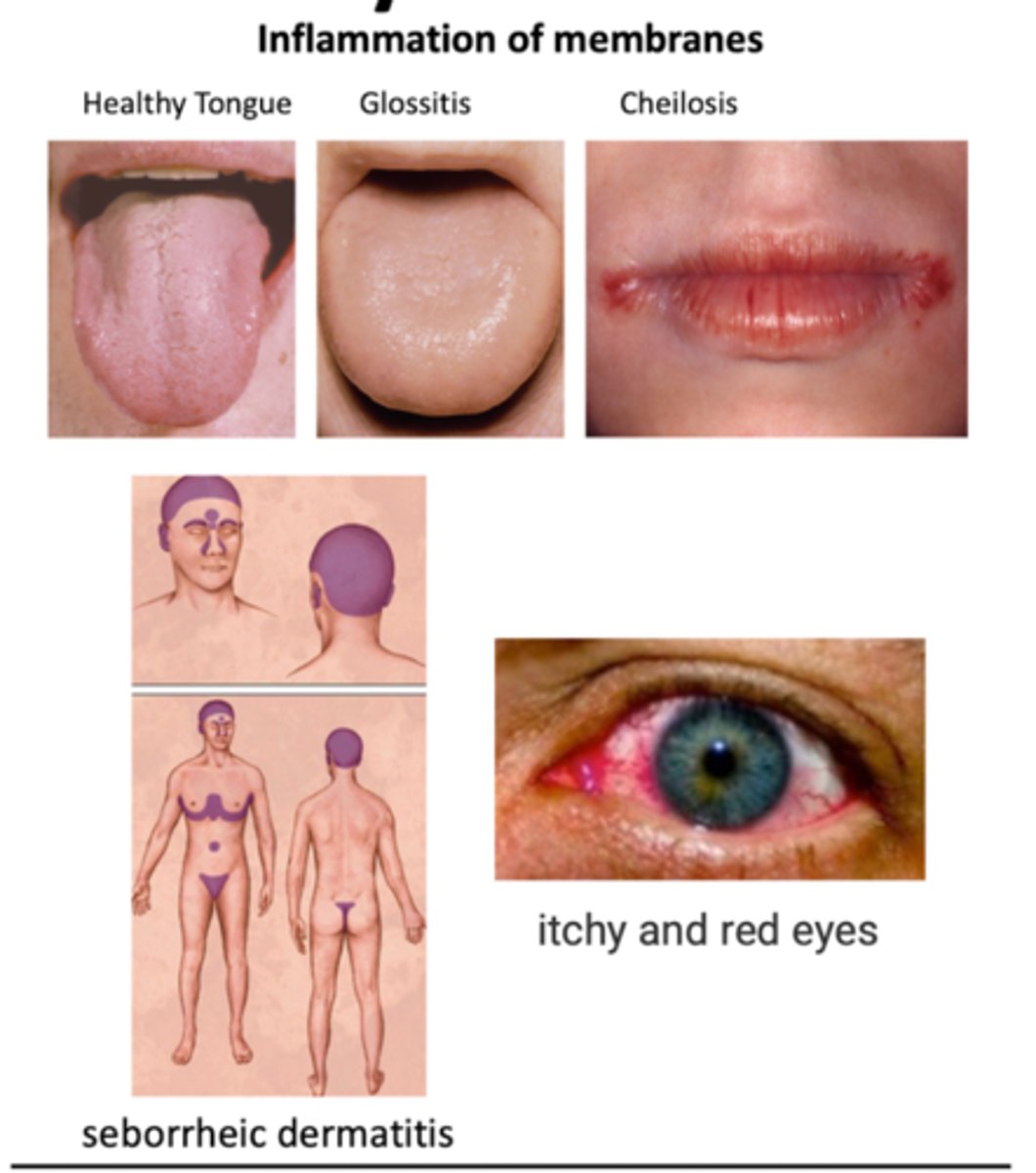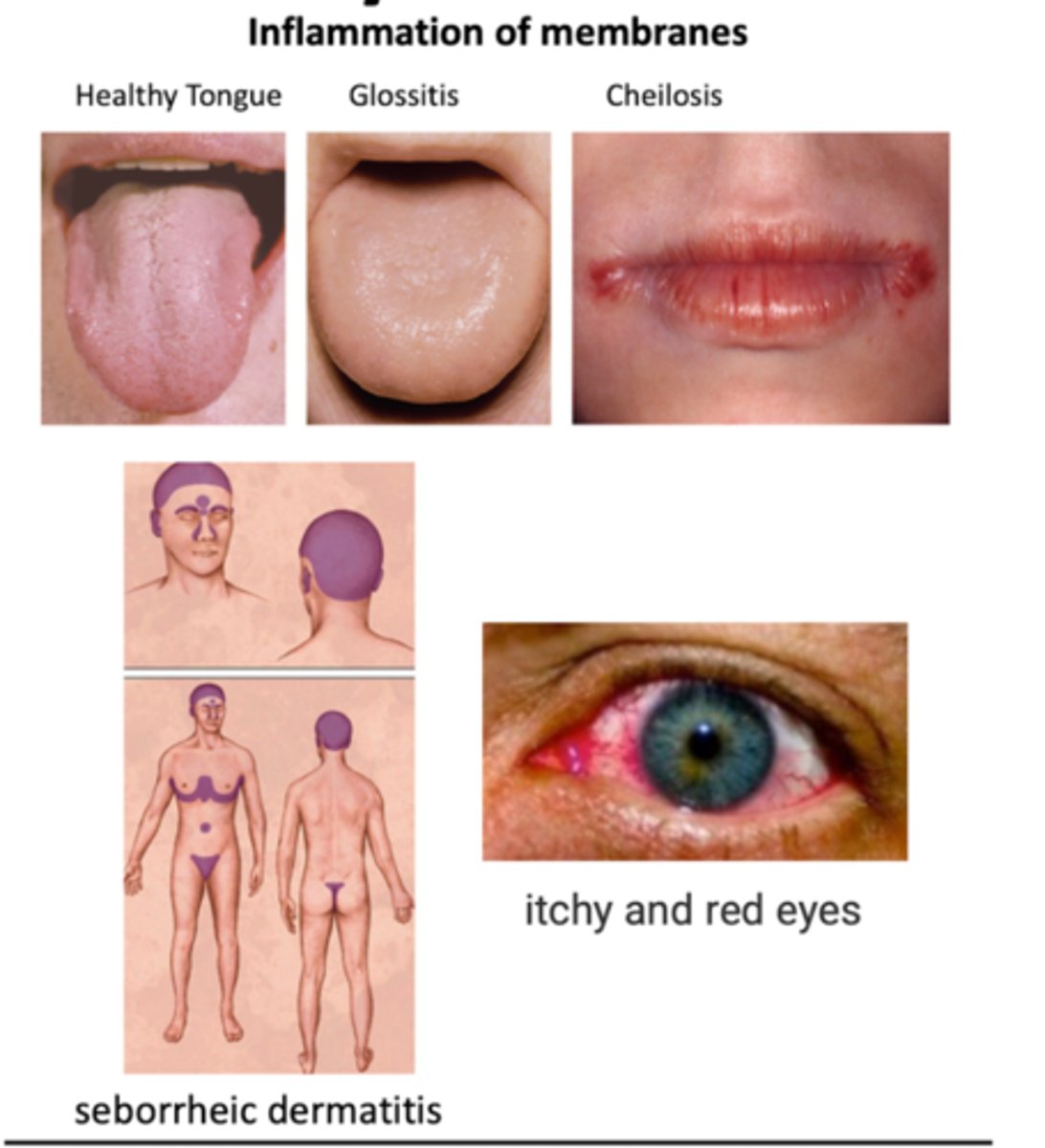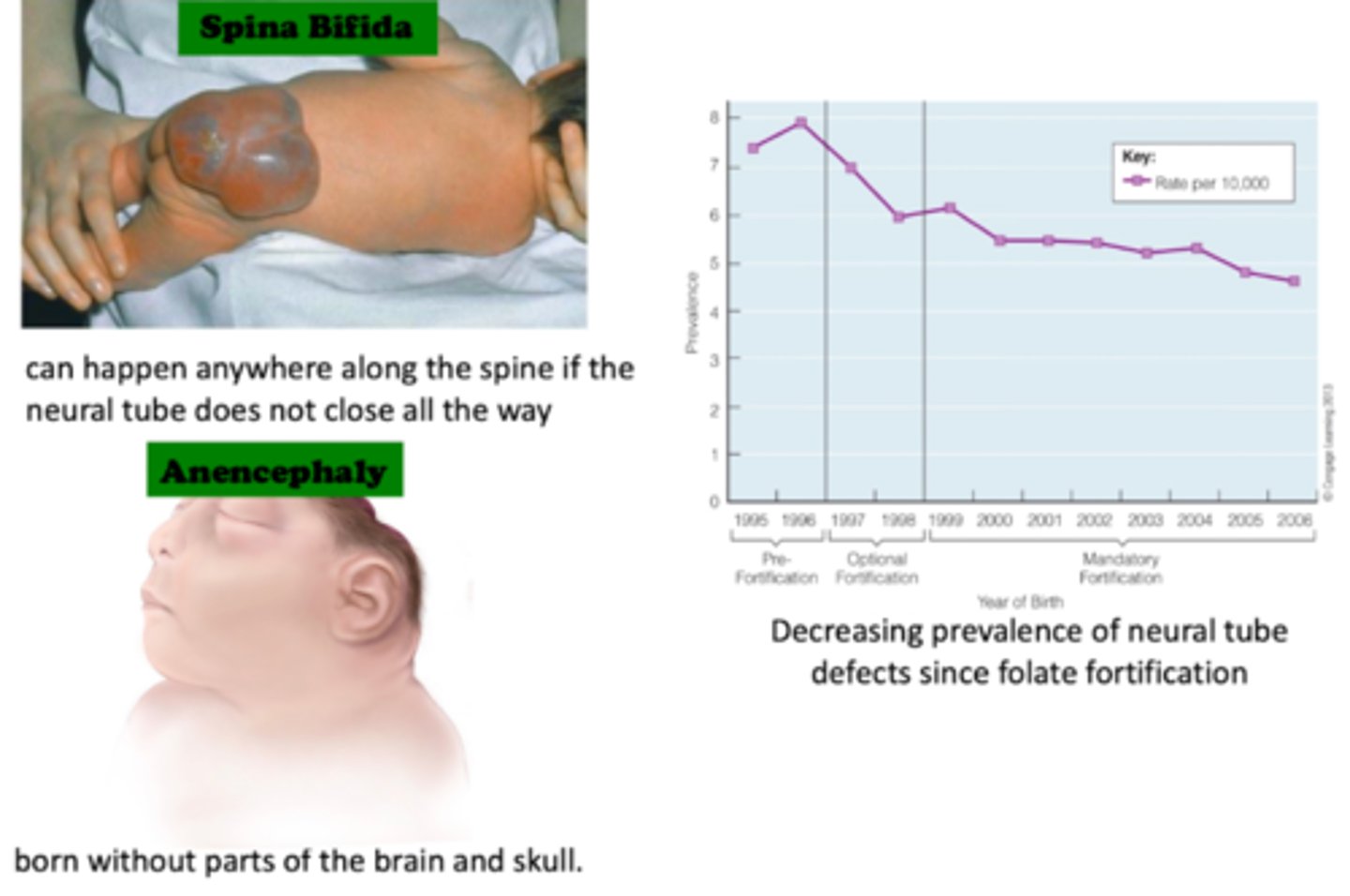Water-Soluble Vitamins in Metabolism
1/20
There's no tags or description
Looks like no tags are added yet.
Name | Mastery | Learn | Test | Matching | Spaced |
|---|
No study sessions yet.
21 Terms
What is vitamin B1? What are some characteristics of its function?
Thiamine - one of the ATP vitamins. TPP is the biologically active form of the vitamin - formed by the transfer of the pyrophosphate group from ATP to thiamine. Essential for heart, muscle, and nerve function - involved in a-ketoglutarate dehydogenase, transketolase, pyruvate dehydrogenase, and branched-chain a-ketoacid dehydrogenase (ATPB).
What are some characteristics of vitamin B1 deficiency?
Vitamin B1 deficiency is typically caused by alcohol abuse, leading to development of Wernicke Korsakoff syndrome (related to transketolase), and Beriberi (Dry leading to muscle wasting and neurological disorder; Wet leading to edema from cardiovascular problems)
What are some characteristics of Beriberi disease?
Severe thiamine-deficiency syndrome in areas with severe malnutrition or where starchy, low-thiamine foods (polished rice) is a major component of diet.
Adult BB is classified as dry (peripheral neuropathy, esp in legs) or wet (edema bc of dilated cardiomyopathy).
What are some characteristics of Wernicke-Korsakoff disease?
Thiamine-deficiency state characterized by mental confusion, gait ataxia, nystagmus (to-and-fro motion of eyeballs), and ophthalmoplegia (weakness of eye muscles) with Wernicke's encephalopathy and memory problems and hallucinations with Korsakoff dementia - this is treatable with thiamine supplementation, but recovery of memory is treatable with thiamine supplementation, but recovery of memory is typically incomplete.
What is vitamin B2? What are some characteristics of its function?
Riboflavin - one of the ATP vitamins. Two bioactive forms are flavin mononucleotide (FMN) and flavin adenine dinucleotide (FAD) formed by transfer of AMP from ATP to FMN. Used in ATP production (TCA and fatty acid oxidation), synthesis/activation of vitamins (A, folate, niacin, B6, and K), and neurotransmitter metabolism (dopamine, NE), and involved in oxidation and reduction reactions (glutathione reductase for ROS removal)
What are some characteristics of vitamin B2 deficiency?
Deficiency is not associated with major disease, tho it frequently accompanies other vitamin deficiencies.
It does cause inflammation of membranes, leading to symptoms such as glossitis, cheilosis, seborrheic dermatitis, and itchy/red eyes.

What is vitamin B3? What are some characteristics of its function?
Niacin - one of the ATP vitamins. It is involved in many redox reactions (prod/breakdown of glucose, fats, AAs, and DNA). Its active coenzyme forms are nicotinamide adenine dinucleotide (NAD+) and its phosphorylated derivative, nicotinamide adenine dinucleotide phosphate (NADP+). NAD and NADP are coenzymes in redox reactions and undergo reduction of pyridine ring by accepting two electrons from hydride ion - reduced forms are NADH and NADPH.
What are some characteristics of vitamin B3 deficiency?
Deficiency causes pellagra (disease involving skin, GI tract, and CNS). Three D's: dermatitis (photosensitive), diarrhea, dementia, and death.
Hartnup disorder characterized by defective absorption of Trp, resulting in pellagra-like symptoms (corn diets can cause pellagra).
What is vitamin B5? What are some characteristics of its function?
Pantothenic acid - one of the ATP vitamins. It takes the form of CoA or Acyl carriers, and is involved in ATP production, synthesis of fatty acids, triacylglycerol, cholesterol, and acetylcholine, and cell membranes.
What are some characteristics of vitamin B5 deficiency?
Deficiency is not well characterized in humans, and no RDA has been established
What is vitamin B7? What are some characteristics of its function?
Biotin - one of the ATP vitamins. It is produced by GI bacteria and functions as a co-enzyme that adds CO2 to compounds; it is required for metabolism of carbohydrates, fats, and proteins. ABC carboxylase (ATP, Biotin, and CO2).
What are some characteristics of vitamin B7 deficiency?
Deficiency does not occur naturally, but raw egg whites to diet (avidin that binds tightly) can induce symptoms of deficiency: dermatitis, hair loss, loss of appetite, and nausea) - need 20 eggs per day to cause symptoms
What is vitamin B6? What are some characteristics of its function?
Pyridoxine. It is involved in amino acid and urea metabolism, conversion of tryptophan to niacin or serotonin, synthesis of neurotransmitters and synthesis of heme. It is a coenzyme for large number of enzymes (that catalyze reactions involving amino acids like transsulfuration of Hcy to cysteine, and in synthesis of dopamine and serotonin), and also required for glycogen phosphorylase. Involved in transaminations, deaminations, decarboxylations, and condensations.
What are some characteristics of vitamin B6 deficiency?
Deficiencies in pyridoxine is rare but seen in newborn infants fed formulas low in B6, woman taking oral contraceptives, and those with alcoholism. It leads to microcytic hypochromic anemia, leads to symptoms such as cheilosis, glossitis, pellagra-like dermatitis, depression, and confusion. Also peripheral neuropathy, depression, confusion
The only water soluble vitamin with significant toxicity – neurological symptoms (sensory neuropathy) occur at intakes above 500 mg/day. Toxicity of B6 leads to irreversible nerve degeneration

What is vitamin B9? What are some characteristics of its function?
Folate - one-carbon transfer. Is involved in the synthesis of DNA, RNA, and some amino acids (critical for rapidly dividing cells), regenerating methionine from homocysteine.
What are some characteristics of vitamin B9 deficiency?
Its deficiencies lead to macrocytic anemia (symptoms of weakness, fatigue, headache, palpitations, and shortness of breath). Nutritional anemia can be classified accoruding to size of RBCs (MCV): microcytic is MCV below norm (lack of iron), macrocytic is MCV above norm (folic acid deficient or vit B12). Inadequate folate levels/demand, poor absorption, alcoholism, or methotrexate can lead to megaloblastic anemia, which is caused by diminished synthesis of purine nucleotides and TMP, leading to inability to make DNA. Neural tube defects: Spina Bifida and anencephaly are the most common NTDs - folic acid supplementation before conception helps

What is vitamin B12? What are some characteristics of its function?
Cobalamin - the methionine and methylmalonyl CoA one. Cobalamin contains a corrin ring similar to porphyrin ring system, but two pyrrole rings are linked directly, and cobalt is held the center of the ring by four coordination bonds - other two are with nitrogen of 5,6-dimetylbenzimidazole and cyanide in commercial.
Coenzyme forms: 5'-deoxyadenosylcobalamin and methylcobalamin
How is vitamin B12 absorbed?
Free B12 binds to glycoprotein (R-protein or haptocorrin) and that complex moves into the intestine. B12 is released from that complex by pancreatic enzymes and then binds to another glycoprotein, intrinsic factor (IF). This B12-IF complex travels to intestines and binds to a receptor, cubilin, on the surface of mucosal cells. The B12 is transported in and then enters general circulation carried by transcobalamin (binding protein). It is then taken up and stored in the liver.
B12 is released into the bile and efficiently reabsorbed in the ileum.
Malabsorption of B12 leads to pernicious anemia - usually a result of autoimmune destruction of gastric parietal cells responsible for IF synthesis (lack prevents B12 absorption).
PA requires lifelong treatment with either high dose oral B12 or intramuscular injection of cyanocobalamin.
Can test impaired absorption (Schilling Test) and tested by levels of methylmalonic acid in blood
What are some characteristics of vitamin B12 deficiency?
its deficiencies can be a result of pure vegan diets or malnutrition, malabsorption (in pernicious anemia and autoimmune inactivation of intrinsic factor (IF) needed for proper absorption of B12, and folate trap. When deficient, unusual FAs accumulate and become incorporated into the cell membrane (accounting for neurologic manifestations of B12 deficiency). Effects of B12 deficiency is pronounced in RBCs bc rapidly dividing.
B12 lead to inability to use methylated form of THF bc it cannot be directly converted into other forms of THF (folate trapped in N5-methyl form).
So cobalamin deficiency lead to deficiency of the THF forms needed for purine and TMP pathways.
Symptoms of deficiencies include megaloblastic anemia, nerve damage (tingling hands and feet), and painful swollen tongue.
What is vitamin C? What are some characteristics of its function?
Ascorbic acid - the antioxidant. involved in formation of collagen (strengthening bones/blood vessels, anchoring teeth into the gums, tissues repair, wound healing), water soluble antioxidant, synthesis of neurotransmitters, synthesis of carnitine, and increases bioavailability of iron from goods by enhancing intestinal absorption of nonheme iron.
Prolyl hydroxylase (aka proline hydroxylase)
Lysyl hydroxylase (lysine hydroxylase)
Also facilitates absorption of dietary nonheme iron from intestin ebay reduction of ferric to ferrous iron.
What are some characteristics of vitamin C deficiency?
Results in scurvy, with symptoms such as sore/spongy gums, loose teeth, fragile blood vessels, hemorrhage, swollen joints, bone changes, and fatigue.
also, decreased hydroxylation of collagen, resulting in defective connective tissue - also microcytic anemia bc iron absorption impaired.
